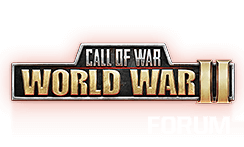- Revolts
- Revolts should result in the creation of enemy units and should be more likely, longer.
- A revolting province should at least create a militia unit.
- Were the revolting province to overpower a garrison, they should capture the garrison's equipment, resulting in the creation of a similar unit. Infantry destroyed? New Infantry Regiment created. Tank Regiment overwhelmed? New Tank Regiment.
- As a consideration, maybe degrade the level of the captured unit, or in some cases the tech tree.
- Infantry lvl 1 becomes militia. Mechanized lvl 1 becomes Motorized or just foot, ect ...
- Infantry lvl 1 becomes militia. Mechanized lvl 1 becomes Motorized or just foot, ect ...
- As a consideration, maybe degrade the level of the captured unit, or in some cases the tech tree.
- A revolting province should at least create a militia unit.
- Revolt chances should remain a threat up till 50%.
- Revolts should result in the creation of enemy units and should be more likely, longer.
- Integration
- This idea should be more controversial. But hear me out.

- There is a very real law of diminishing returns on conquests in this game. As the game progresses towards end game, the chances that improving a territory will result in positive revenue decreases rapidly. I haven't done the math with any completeness, but what little quick and conservative math I did indicates to me that if you conquer a city after the first two weeks, building industry there is a resource loss.
- It looks like it takes at least 32 days to make up the cost of fully upgrading a captured city, before one counts propaganda costs, and moral effects.
- It looks like it takes at least 32 days to make up the cost of fully upgrading a captured city, before one counts propaganda costs, and moral effects.
- I propose a building that is only for territories that are not core.
- it should only be buildable when moral is 100%.
- some consideration might be given to the idea that it can only be built after the original owning country has been eliminated.
- some consideration might be given to the idea that it can only be built after the original owning country has been eliminated.
- it should be more time expensive than resource expensive.
- it should result in the territory becoming 'core', and all the resources can be harvested.
- it should ALWAYS be destroyed when an enemy player takes the province.
- it should only be buildable when moral is 100%.
- the result should be a choice between building war production, or building civilian buildings.
- the length of the time that it takes to build should be long enough that if a player needs to build armies faster, they shouldn't build this building.
- the ultimate math of the situation should be that a player should gain resource value out of a province that has this building built before 66% (or there abouts) of the games completion.
- the length of the time that it takes to build should be long enough that if a player needs to build armies faster, they shouldn't build this building.
- This idea should be more controversial. But hear me out.
Furthermore, the proposed integration mechanic addresses the law of diminishing returns on conquests, forcing players to consider the long-term viability of their acquisitions. By introducing a building exclusive to non-core territories, contingent on 100% morale and potentially tied to the elimination of the original owning country, the game introduces a strategic choice. Players must carefully decide whether to invest time in building this structure, which transforms a territory into a 'core,' allowing the full exploitation of its resources. This strategic decision-making adds depth to the late-game phase, where players must balance the need for immediate military production with the long-term benefits of resource harvesting. The destruction of the building upon an enemy player's capture of the province adds a layer of risk, creating a dynamic where careful planning and execution are paramount. Ultimately, this system encourages players to engage in a thoughtful cost-benefit analysis, reinforcing the importance of strategic foresight in the pursuit of victory.
